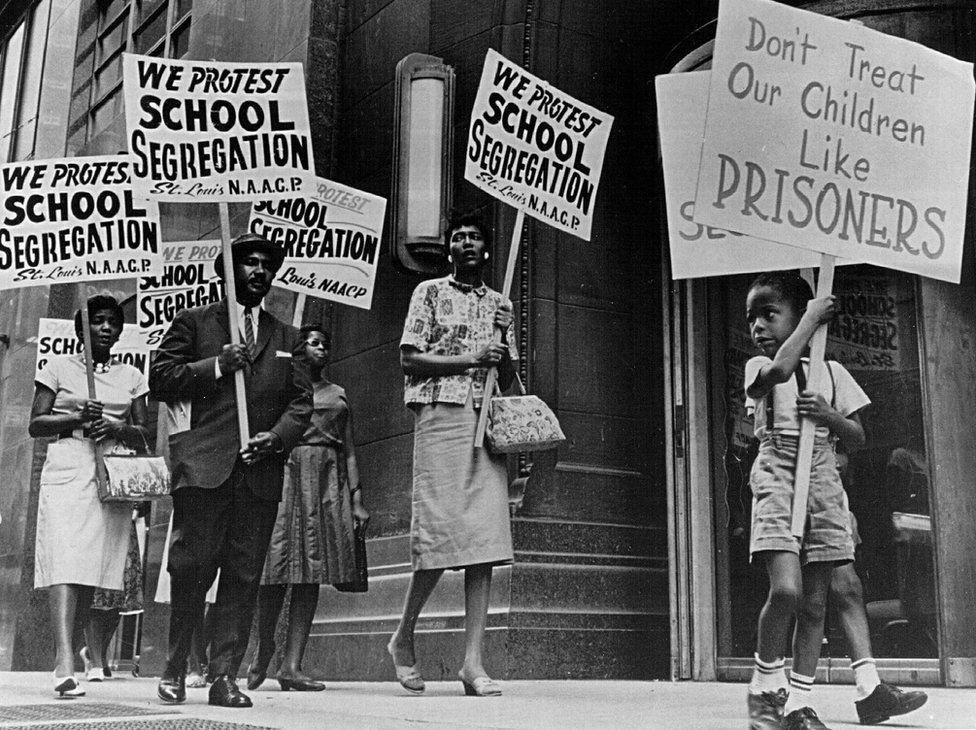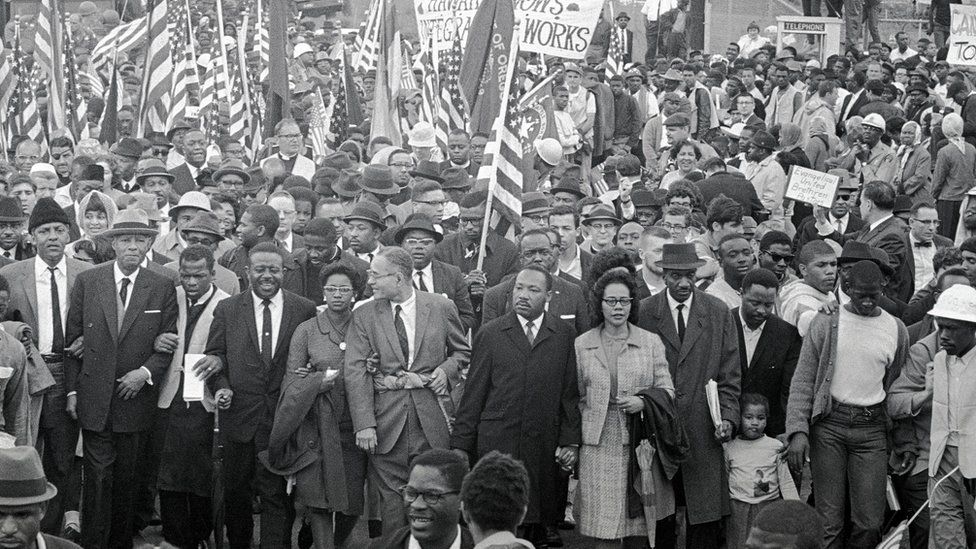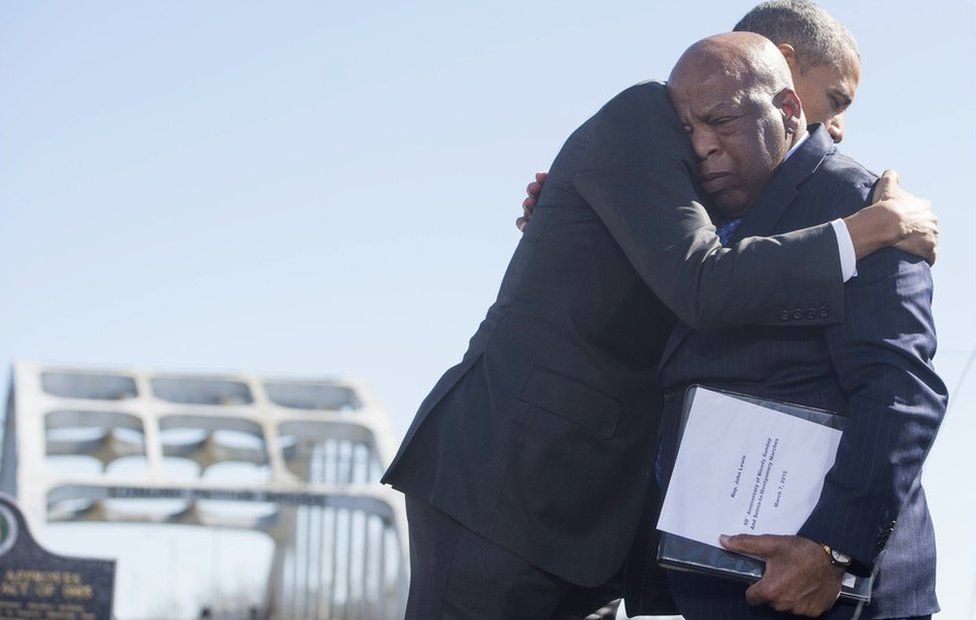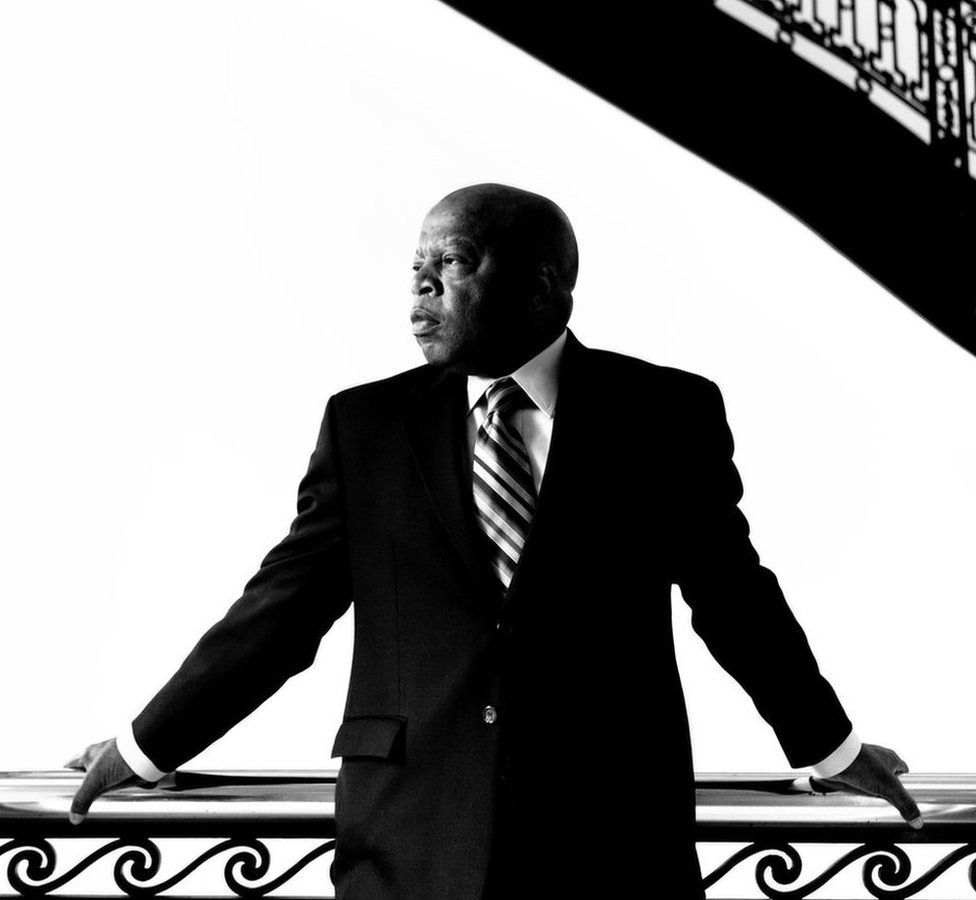“Hold only love, only peace in your heart, knowing that the battle of good to overcome evil is already won.
“Choose confrontation wisely, but when it is your time don’t be afraid to stand up, speak up, and speak out against injustice.”
John Lewis forged his legacy as a lifetime champion for civil rights and racial equality during the struggles of the 1960s as he preached a message of non-violence alongside Dr Martin Luther King Jr.
It was in March 1965 that Lewis, aged only 25, stood with King and other civil rights leaders as they led peaceful protesters across the Edmund Pettus Bridge in Selma, Alabama. Their planned march would take them to Montgomery, the state capitol, to demand equal voting rights.
As they crossed the bridge, armed Alabama police officers on horseback carrying tear gas, whips and bully clubs attacked them. At least 40 protesters required treatment, and Lewis suffered a fractured skull.
Media outlets from across America captured the brutal attack on film, calling it Bloody Sunday. The event became a pivotal moment in the battle for civil rights for African-Americans, as Americans outside the South could now see the abuse inflicted upon the black community under “Jim Crow” segregation laws.
Five months later, with Lewis among the collection of civil rights leaders at the White House, President Lyndon Johnson signed the Voting Rights Act of 1965 into law.
Lewis was born on 21 February, 1940, during the time of Jim Crow laws, to a family of sharecroppers in the small Southern town of Troy, Alabama.
He was one of 10 children, and from an early age he expressed an obvious love of learning. Lewis would spend hours upon hours at his local library, and it was here where he could find African-American publications that would embolden his commitment to the struggle for civil rights.
“I loved going to the library,” said Lewis. “It was the first time I ever saw black newspapers and magazines like JET, Ebony, the Baltimore Afro-American, or the Chicago Defender. And I’ll never forget my librarian.”
As a young black man growing up in the American South, the battle for racial equality actively shaped his life long before he became an activist. In 1954, when Lewis was only 13, the Supreme Court, in a unanimous decision, ruled in favour of Brown vs Board of Education, striking down more than 50 years of legalised racial segregation.
Alabama, along with many other states, fought the decision and delayed implementation of school desegregation. Lewis’ school remained segregated despite Brown, and Alabama’s commitment to segregation forced him to leave the state to attend college.

Lewis aspired to attend the nearby, all-white Troy State University and study for the ministry, but the school’s segregationist stance meant it would never accept him.
In 1957, Lewis finally decided on attending the predominantly African-American institution, the American Baptist Theological Seminary in Nashville, Tennessee, because it allowed students to work for the school in lieu of tuition. Yet during his first year in Nashville, as the fight against segregation continued, Lewis attempted to transfer to Troy State.
He sent in an application, but never heard back from the school. It was common during this time for segregationist schools to ignore the applications of African-Americans instead of formally accepting or denying them.
After growing frustrated by Troy State’s lack of response, Lewis wrote a letter to King describing his dilemma. King responded by sending Lewis a round-trip bus ticket to Montgomery so they could meet.
This meeting would commence Lewis’ relationship with King and his lifelong leadership in the struggle for civil rights.
Lewis eventually decided to end his dream of entering Troy State University after consulting King. Lewis’ parents had also feared their son would be killed, and their land taken away, if he continued to challenge Jim Crow laws. Instead, Lewis returned to Nashville, graduated from the seminary, and went on to earn a Bachelor of Arts in religion and philosophy.
Throughout college, Lewis remained an important figure in the civil rights movement, organising sit-ins at segregated lunch counters. In 1961 he became one of the 13 original Freedom Riders, seeking to end the practice of segregation on public transport.
At the time, several southern states had laws prohibiting African-Americans and white riders from sitting next to each other on public transportation or in bus terminals. The original 13 – seven white and six black – attempted to ride from Washington to New Orleans. In Virginia and North Carolina, the Freedom Riders evaded conflict, but all of that changed as they moved further south.
In May 1961, Lewis was attacked by a mob of white men at a bus station in Rock Hill, South Carolina, for attempting to enter a waiting room marked “Whites”. Lewis was beaten and bloodied on that day, but his commitment remained undeterred.
In the Deep South, Lewis and other Freedom Riders were beaten by angry mobs, arrested, and jailed for sitting or standing next to white people on buses and in bus terminals. Some of the original riders left due to the violence and terror, but Lewis continued all the way to New Orleans.
In 2009, Lewis was reunited with his Rock Hill attacker, only this time instead of a clenched fist he was shown an open hand and a request for forgiveness. Elwin Wilson, a former Klansman who attacked Lewis, said that the election of President Barack Obama had spurred him to admitting his hateful acts and to ask for forgiveness from Lewis.
“I said if just one person comes forward and gets the hate out of their heart, it’s all worth it,” said Wilson. “I never dreamed that a man that I had assaulted, that he would ever be a congressman and that I’d ever see him again.
“He was very, very sincere, and I think it takes a lot of raw courage to be willing to come forward the way he did,” said Lewis. “I think it will lead to a great deal of healing.”
In 1963, when aged only 23, Lewis became the chairman of the Student Nonviolent Coordinating Committee (SNCC), making him one of the “Big Six” civil rights leaders of the era. These leaders would organise the 1963 March on Washington, where King would give his historic “I Have A Dream” speech. Lewis, at an age when most people had just begun their professional careers, also stood atop the Lincoln Memorial and gave a rousing oration about the importance of fighting for civil rights.
“We are tired,” Lewis said in his speech. “We are tired of being beaten by policemen. We are tired of seeing our people locked up in jail over and over again. And then you holler, ‘Be patient’. How long can we be patient? We want our freedom and we want it now.”

In March 1965, Lewis, King and other civil rights leaders organised the march from Selma to Montgomery that became a tipping point in the battle for civil rights and the eventual passage of the 1965 Voting Rights amendment.
Throughout his early civil rights career, King remained Lewis’ mentor, the man Lewis said “was like a big brother to me”.
“[He] inspired me to get in trouble – what I call good trouble, necessary trouble,” Lewis later told the Washington Post. “And I’ve been getting in trouble ever since.”
Lewis was in Indianapolis in April 1968, campaigning with Democratic presidential candidate Bobby Kennedy, when Kennedy announced that King had been assassinated.
“It was such an unbelievable feeling,” Lewis said. “I cried. I just felt like something had died in all of us when we heard that Dr Martin Luther King Jr had been assassinated. But I said to myself, well, we still have Bobby. And a short time later, he was gone.”
After leaving the SNCC in 1966, Lewis remained active in civil rights in Atlanta, working on voter registration programmes and on helping people rise out of poverty.
When Jimmy Carter won the successful presidential bid, Lewis took a position with the federal domestic volunteer agency and in 1981, after Carter lost the White House to Republican Ronald Reagan, Lewis returned to Atlanta and was elected to the City Council.
Five years later he ran successfully for Georgia’s fifth congressional district, and held his seat until his passing.
To help acquaint a new generation of Americans with the fight for civil rights in the 1960s, Lewis co-created the three-part graphic novel March, a vivid memoir of his lifetime of civil rights advocacy that went on to be a bestseller and award-winner.
As a young activist, Lewis had himself been inspired by the 1958 comic book Martin Luther King and the Montgomery Story. Through his own graphic novel, he hoped to inspire another generation of civil rights leaders.
“We are involved now in a serious revolution,” it says in March: Book Two, published in 2015. “This nation is still a place of cheap political leaders who build their careers on immoral compromises and ally themselves with open forms of political, economic and social exploitation.
“What political leader here can stand up and say, ‘My party is the party of principles?'”
In 2014, the film Selma depicted the events of Lewis’ historic march across the Edmund Pettus Bridge, and was released to wide acclaim. It further cemented Lewis’ legacy as a civil rights icon.
He recreated the journey across the bridge in March 2015, but this time with Barack Obama, America’s first black president.
“It is a rare honour in this life to follow one of your heroes, and John Lewis is one of my heroes,” Obama said at the 50th anniversary celebration.

During Donald Trump’s presidency, Lewis fiercely opposed the policies and statements made by the president and his fellow Republicans. Lewis boycotted Trump’s inauguration, saying he did not believe he was a “legitimate president” because of Russian interference in the 2016 election.
He went on to repeat concerns about the direction he felt the US was taking in 2017, after the white supremacist rally and attack in Charlottesville, Virginia.
“I am very troubled,” he said. “I cannot believe in my heart what I am witnessing today in America. I wanted to think not only as an elected official, but as a human being that we had made more progress. It troubles me a great deal.”
Despite this Lewis remained an undeterred and committed champion for the fight for civil rights and racial equality until his last breath.
“When you see something that is not right, not fair, not just, you have to speak up. You have to say something; you have to do something” – John Lewis.
Source: BBC


